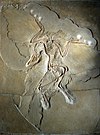Archaeopteryx is a genus of early bird that is transitional between feathered dinosaurs and modern birds. Since the late nineteenth century, it had been generally accepted by palaeontologists, and celebrated in lay reference works, as being the oldest known bird. Archaeopteryx lived in the Late Jurassic period around 150 million years ago, in what is now southern Germany during a time when Europe was an archipelago of islands in a shallow tropical sea. Similar in shape to a European Magpie, with the largest individuals possibly attaining the size of a raven, Archaeopteryx could grow to about 0.5 m (1 ft 8 in) in length. Despite its small size, broad wings, and inferred ability to fly or glide, Archaeopteryx has more in common with other small Mesozoic dinosaurs than it does with modern birds. In particular, it shares the following features with the deinonychosaurs (dromaeosaurs and troodontids): jaws with sharp teeth, three fingers with claws, a long bony tail, hyperextensible second toes ("killing claw"), feathers (which also suggest homeothermy), and various skeletal features.
These features make Archaeopteryx a clear candidate for a transitional fossil between dinosaurs and birds. The type specimen of Archaeopteryx was discovered just two years after Charles Darwin published On the Origin of Species. Archaeopteryx seemed to confirm Darwin's theories and has since become a key piece of evidence for the origin of birds, the transitional fossils debate, and confirmation of evolution. (see more...)
